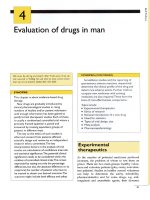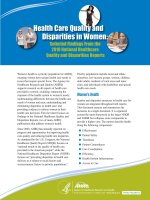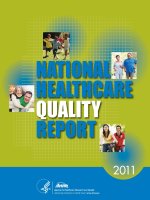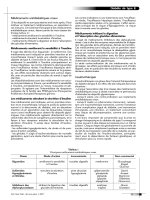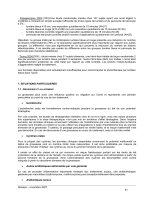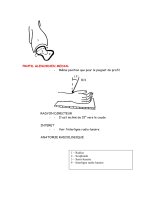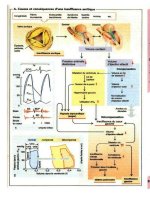National Healthcare Quality Report - part 6 doc
Bạn đang xem bản rút gọn của tài liệu. Xem và tải ngay bản đầy đủ của tài liệu tại đây (154.97 KB, 15 trang )
National Healthcare Quality Report
Effectiveness
Mental Health and Substance Abuse
CHAPTER 2
70
the rate of persons who complete all parts of their treatment plan. This section highlights three core measures
of mental health and substance abuse treatment:
•
Suicide death rate.
•
Receipt of treatment for illicit drug use.
•
Receipt of treatment for depression.
Findings
Prevention: Suicide Deaths
Suicide is often the result of untreated depression and may be prevented when its warning signs are detected
and treated.
Figure 2.33. Suicide deaths per 100,000 population, 2000-2004
Source: Centers for Disease Control and Prevention, National Center for Health Statistics, National Vital Statistics System – Mortality, 2000-
2004.
Reference population: Age 5 and over.
Note: Total rate is age adjusted to the 2000 U.S. standard population.
•
From 2000 to 2004, the suicide death rate increased for the population as a whole (from 10.4 to 10.9
deaths per 100,000 population), moving further away from the Healthy People 2010 target of 5.0 suicide
deaths per 100,000 population (Figure 2.33).
•
From 2000 to 2004, the rate of suicide deaths per 100,000 population for children ages 5-17 remained
relatively stable. During the same period, the rate decreased for adults age 65 and over (from 15.2 to
14.3) and increased for adults ages 45-64 (from 13.2 to 15.4).
•
In all five data years, the rate of suicide deaths was higher for adults age 65 and over than for adults ages
18-44, and lower for children ages 5-17 than for adults ages 18-44.
•
Continuation of these or similar rates could account for at least 160,000 deaths resulting from suicide
over the period from 2005 to 2010.
0
2
4
6
8
10
12
14
16
18
2
0
0
1
2
0
0
2
1
0
.
8
Total
1
4
.
4
2
0
0
3
Ages 5-17
18-44
45-64
D
e
a
t
h
s
p e
r
1
0
0
,
0
0
0
p o
p u
l
a
t
i
o
n
1
0
.
9
1
3
.
5
1
3
.
4
1
5
.
0
1
.
5
1
.
4
1
0
.
4
1
4
.
6
1
3
.
3
1
.
3
1
.
3
65 and over
1
0
.
7
1
5
.
2
1
5
.
3
1
5
.
6
1
3
.
0
2
0
0
0
1
3
.
2
1
4
.
9
1
0
.
9
1
4
.
3
1
5
.
4
1
.
4
1
3
.
5
2
0
0
4
H P
2
010
T
ar
g
et
:
5.
0
p er
100,
000
p o
p u l
at
i
o
n
Figure 2.34. State variation: Suicide deaths per 100,000 population, 2004
Source: Centers for Disease Control and Prevention, National Center for Health Statistics, National Vital Statistics System – Mortality, 2004.
Key: Above average = rate is significantly above the reporting States average in 2004. Below average = rate is significantly below the
reporting States average in 2004.
Reference population: U.S. population.
Note: Rates are age adjusted to the 2000 standard population. The “reporting States average” is the average of all reporting States (51 in
this case, including the District of Columbia), which is a separate figure from the national average.
•
The State rates of suicide deaths per 100,000 population ranged from a low of 5.7 to a high of 23.4
(Figure 2.34).
•
In 2004, 11 States
xix
had rates of suicide deaths that were lower than the reporting States average of 10.8
per 100,000 population, with a combined average rate of 7.8 per 100,000 population. No State has yet
reached the Healthy People 2010 goal of 5.0 per 100,000 population.
•
In 2004, 24 States
xx
had rates of suicide deaths that were higher than the reporting States average, with a
combined average rate of 15.3 per 100,000 population.
•
Michigan is the only State that showed a significant change in the rate of suicide deaths from 1999 to
2004. Over this period, the rate of suicide deaths in Michigan increased from 9.9 to 10.8 per 100,000
population.
xix
The States are California, Connecticut, District of Columbia, Hawaii, Illinois, Maryland, Massachusetts, Nebraska, New
Jersey, New York, and Rhode Island.
xx
The States are Alaska, Arizona, Arkansas, Colorado, Florida, Idaho, Kansas, Kentucky, Louisiana, Mississippi, Missouri,
Montana, Nevada, New Mexico, North Carolina, Oklahoma, Oregon, South Dakota, Tennessee, Utah, Vermont, Washington,
West Virginia, and Wyoming.
National Healthcare Quality Report
Effectiveness
Mental Health and Substance Abuse
CHAPTER 2
71
Lower rate
Average rate
Higher rate
DC
No data
PR
National Healthcare Quality Report
Effectiveness
Mental Health and Substance Abuse
CHAPTER 2
72
Treatment: Receipt of Needed Treatment for Illicit Drug Use
Substance abuse is a medical problem that requires timely treatment, not only because of its health effects but
also because drug use is associated with other adverse effects, such as violent behavior. In addition, because
overall health care costs may be reduced by effective substance abuse and mental health treatment,
35, 36
appropriate receipt and completion of treatment have both clinical and economic implications.
Figure 2.35. Persons ages 12-44 who received needed treatment for illicit drug use, 2002-2005
Source: Substance Abuse and Mental Health Services Administration, National Survey on Drug Use and Health, 2002-2005.
Reference population: Civilian noninstitutionalized population ages 12-44 who needed treatment for any illicit drug use.
Note: Treatment refers to treatment at a specialty facility, such as a drug and alcohol inpatient and/or outpatient rehabilitation facility,
inpatient hospital care, or a mental health center.
•
Overall, 17.0% of persons ages 12-44 who met criteria for needing treatment for illicit drug use actually
received it in 2005. This rate has not changed significantly since 2002 (Figure 2.35).
•
Of people who needed treatment for illicit drug use in 2005, only 17.5% of adults ages 18-44 and 11.3%
of children ages 12-17 received it. These rates remain statistically unchanged from 2002.
•
In all four data years, children ages 12-17 who needed illicit drug treatment were less likely than adults
ages 18-44 to receive such treatment.
0
5
10
15
20
25
2
0
0
2
2
0
0
3
Total
2
0
0
4
12-17
18-44
P
e
r
c
e
n
t
1
8
.
2
1
6
.
0
1
5
.
0
1
7
.
7
1
7
.
2
8
.
5
9
.
6
1
0
.
1
1
8
.
0
1
7
.
0
1
1
.
3
1
7
.
5
2
0
0
5
National Healthcare Quality Report
Effectiveness
Mental Health and Substance Abuse
CHAPTER 2
73
Treatment: Receipt of Treatment for Depression
Almost 10% of the U.S. population will have a major depressive episode in their lifetime. Treatment can be
very effective in reducing symptoms and associated illnesses and returning individuals to a productive lifestyle.
Figure 2.36. Adults ages 18-64 with a history of major depressive episode in the past year who received treatment for
depression in the past year, by age group, 2004 and 2005
Source: Substance Abuse and Mental Health Services Administration, National Survey on Drug Use and Health, 2004 and 2005.
Reference population: U.S. civilian noninstitutionalized population ages 18-64.
•
In 2005, 65.6% of adults ages 18-64 with a major depressive episode received treatment for depression
(Figure 2.36). There was no significant improvement in this measure compared with 2004.
•
In 2005, among adults who experienced a major depressive episode, those ages 45-64 (75.5%) were more
likely than those ages 18-44 (58.7%) to receive treatment for depression. The 45-64 age group was also
more likely to receive treatment in 2004.
50
55
60
65
70
75
80
8
5
90
95
100
2004
P
e
r
c
e
n
t
5
9
. 5
Total
18-44
45-64
6
5
. 1
6
5
. 6
7
3
.
5
0
Z
2005
7
5
.
5
5
8
. 7
National Healthcare Quality Report
Effectiveness
Respiratory Diseases
CHAPTER 2
74
Respiratory Diseases
Importance and Measures
Mortality
Number of deaths due to lung diseases (2003). . . . . . . . . . . . . . . . . . . . . . . . . . . . . . . . . . . . . . . . . . . . 243,000
37
Number of deaths, influenza and pneumonia combined (2004) . . . . . . . . . . . . . . . . . . . . . . . . . . . . . . . . 59,664
2
Cause of death rank, influenza and pneumonia combined (2004) . . . . . . . . . . . . . . . . . . . . . . . . . . . . . . . . . 8th
2
Prevalence
People 18 and over who have asthma (2005). . . . . . . . . . . . . . . . . . . . . . . . . . . . . . . . . . . . . . . . . . . 15,697,000
38
People under 18 who have asthma (2005) . . . . . . . . . . . . . . . . . . . . . . . . . . . . . . . . . . . . . . . . . . . . . . 6,531,000
39
Incidence
Annual number of cases of the common cold (est.) . . . . . . . . . . . . . . . . . . . . . . . . . . . . . . . . . . . . . . >1 billion
40
Annual number of pneumonia cases due to Streptococcus pneumoniae. . . . . . . . . . . . . . . . . . . . . . . . 500,000
41
New cases of tuberculosis (2006) . . . . . . . . . . . . . . . . . . . . . . . . . . . . . . . . . . . . . . . . . . . . . . . . . . . . . . . 13,767
42
Cost
Total cost of lung diseases (2006 est.). . . . . . . . . . . . . . . . . . . . . . . . . . . . . . . . . . . . . . . . . . . . . . . $144.2 billion
4
Direct medical costs of lung diseases (2006 est.). . . . . . . . . . . . . . . . . . . . . . . . . . . . . . . . . . . . . . . $87.0 billion
4
Total approximate cost of upper respiratory infections (annual). . . . . . . . . . . . . . . . . . . . . . . . . . . . $40 billion
43
Total cost of asthma (2004) . . . . . . . . . . . . . . . . . . . . . . . . . . . . . . . . . . . . . . . . . . . . . . . . . . . . . . . $16.1 billion
37
Direct medical costs of asthma (2004) . . . . . . . . . . . . . . . . . . . . . . . . . . . . . . . . . . . . . . . . . . . . . . $11.5 billion
37
Cost effectiveness of influenza immunization . . . . . . . . . . . . . . . . . . . . . . . . . . . . . . . . . . . . $0-$14,000/QALY
5
Note: Statistics may vary from previous years due to revised and updated source statistics or addition of new data sources.
Measures
The NHQR tracks several quality measures for prevention and treatment of this broad category of illnesses
that includes influenza, pneumonia, asthma, upper respiratory infection, and tuberculosis. The five core report
measures highlighted in this section are:
•
Pneumococcal vaccination.
•
Receipt of recommended care for pneumonia.
•
Receipt of antibiotics for the common cold.
•
Completion of tuberculosis therapy.
•
Hospital admissions for pediatric asthma.
National Healthcare Quality Report
Effectiveness
Respiratory Diseases
CHAPTER 2
75
Findings
Prevention: Pneumococcal Vaccination
Vaccination is a cost effective strategy for reducing illness and death associated with pneumococcal disease of
the lungs (pneumonia) and influenza.
Figure 2.37. Noninstitutionalized adults age 65 and over who ever received pneumococcal vaccination, 1999-2005
Source: Centers for Disease Control and Prevention, National Center for Health Statistics, National Health Interview Survey, 1999-2005.
Reference population: Civilian noninstutionalized population age 65 and over.
Note: Age adjusted to the 2000 U.S. standard population.
•
The percent of adults age 65 and over who ever received a pneumococcal vaccination increased from
49.9% in 1999 to 56.3% in 2005 (Figure 2.37). The Healthy People 2010 target of 90% is unlikely to be
met until after 2020 at this rate of change.
CHAPTER 4
25
35
45
55
65
75
85
95
1999
2000
2001
4
9
.
9
5
3
.
4
2002
5
4
.
2
5
6
.
2
5
5
.
7
2003
P
e
r
c
e
n
t
0
Z
2004
5
7
.
0
H P
2
0
1
0
T
a r
g
e t
:
9
0
%
5
6
.
3
2005
National Healthcare Quality Report
Effectiveness
Respiratory Diseases
CHAPTER 2
Figure 2.38. State variation: Adults age 65 and over who ever received pneumococcal vaccination, 2005
Source: Centers for Disease Control and Prevention, Behavioral Risk Factor Surveillance System, 2005.
Reference population: Civilian noninstitutionalized population age 65 and over.
Key: Above average = rate is significantly above the reporting States average in 2005. Below average = rate is significantly below the
reporting States average in 2005.
Note: Age adjusted to the 2000 U.S. standard population. “Reporting States average” is the average of all reporting States (51 in this case,
including the District of Columbia), which is a separate figure from the national average.
•
In 2005, the reporting States average of adults 65 and over who had ever received a pneumococcal
vaccination was 64.1%, with a range from 51.4% to 71.7% (Figure 2.38).
•
Nineteen States
xxi
were significantly above the reporting States average in 2005, with a combined average
rate of 69.3%.
•
Three States
xxii
were significantly below the reporting States average in 2005, with a combined average
rate of 55.2%.
•
Eighteen States showed improvement between 2001 and 2005 in the number of adults age 65 and over
who had ever received a pneumococcal vaccination.
xxiii
No State showed a significant decrease on this
measure over this time period.
xxi
The States are Colorado, Connecticut, Iowa, Louisiana, Michigan, Minnesota, Montana, Nebraska, Nevada, New
Hampshire, North Carolina, North Dakota, Oklahoma, Oregon, Pennsylvania, Rhode Island, Washington, West Virginia, and
Wyoming.
xxii
The States are Arkansas, District of Columbia, and Illinois.
xxiii
The States are Connecticut, Indiana, Kentucky, Louisiana, Michigan, Minnesota, Mississippi, Missouri, Nebraska, New
Hampshire, New Jersey, North Dakota, Oklahoma, Pennsylvania, South Carolina, South Dakota, Tennessee, and West
Virginia.
CHAPTER 4
76
Above average
Average
Below average
DC
PR
No data
Treatment: Receipt of Recommended Care for Pneumonia
Recommended care for patients with pneumonia includes receipt of: (1) initial antibiotics within 4 hours of
hospital arrival; (2) antibiotics consistent with current recommendations; (3) blood culture before antibiotics
are administered; (4) influenza vaccination status assessment/vaccine provision; and (5) pneumonia
vaccination status assessment/vaccine provision. The NHQR tracks receipt of this care for each measure and
as an overall composite.
Figure 2.39. Patients with pneumonia who received recommended care for pneumonia: Overall composite and five
components, 2005
Source: Centers for Medicare & Medicaid Services, Quality Improvement Organization Program, 2005.
Denominator: Patients hospitalized with a principal diagnosis of pneumonia or a principal diagnosis of either septicemia or respiratory
failure and secondary diagnosis of pneumonia.
Note: Beginning in 2005, the data collection method changed from the abstraction of randomly selected medical records for Medicare
beneficiaries to the receipt of hospital self-reported data for all payer types.
•
In 2005, 74.1% of adult patients with pneumonia received the recommended care included in the overall
pneumonia treatment composite measure (Figure 2.39).
•
Among the five components of the composite measure, patients were most likely to receive blood cultures
when clinically appropriate (82.5%) and least likely to have their influenza vaccination status assessed and
receive the vaccine if indicated (56.9%).
•
Revisions to two component measures related to recommended care for pneumonia should be noted:
The individual measure of appropriate antibiotic selection for community-acquired pneumonia
was changed to exclude patients with health-care-associated pneumonia from the denominator
used in the calculation.
National Healthcare Quality Report
Effectiveness
Respiratory Diseases
CHAPTER 2
77
0
10
20
30
40
50
60
70
80
90
100
74.1
P
e
r c
e
n
t
7
6.4
80.4
82.5
A
n
t
i
b
i
o
t
i
c
s
w i
th
i
n
4
h
o
u
r s
A
n
t
i
b
i
o
t
i
c
s
s
e
l
e
c
t
i
o
n
P
n
e
u
m
o c
o
c
c
a
l
v
a
c
c
i
n
a
t
i
o n
s
ta
tu
s
a
s
s
e
s
s
m
e
n
t
/ v
a
c
c
i
n
e
p
r
o
v
i
s
i
o n
I
n
f
l
u e
n
z
a
v
a
c
c
i
n
a
ti
o
n
s
t
a
t
u
s
a
s
s
e
s
s
m
e
n
t
/
v
a
c
c
i
n
e
p
r
o
v
i
s
i
o
n
C
o
m
p
o
s
i
te
B
l
o
o
d
c
u
l
t
u
r e
b
e
f
o
r
e
f
i
r s
t
a
n
t
i
b
i
o t
i
c
d
o s
e
56.9
62.2
National Healthcare Quality Report
Effectiveness
Respiratory Diseases
CHAPTER 2
78
The individual measure for the collection of samples for blood culture within 24 hours of hospital
arrival was changed so that only those patients who were admitted to the intensive care unit within
24 hours of hospital arrival are included in the denominator.
Treatment: Receipt of Antibiotics for the Common Cold
Taking antibiotics does not treat or relieve symptoms of the common cold and may lead to the development of
antibiotic-resistant bacteria. Although antibiotic prescribing patterns are slowly improving, overuse of
antibiotics is still a concern.
44
Children have the highest rates of antibiotic use and the highest rates of
infection with antibiotic-resistant bacterial pathogens.
45
Figure 2.40. Rate of antibiotic drug utilization at ambulatory care visits with a diagnosis of common cold per 10,000
population, overall, for children under age 18, and for adults 65 and over, 1997-2005
Source: Centers for Disease Control and Prevention, National Center for Health Statistics, National Ambulatory Medical Care Survey and
National Hospital Ambulatory Medical Care Survey, 1997-1998, 1999-2000, 2001-2002, 2003-2004, and 2004-2005.
Denominator: U.S. noninstitutionalized population.
•
In 2004-2005, the overall rate of antibiotics prescribed at visits with a diagnosis of the common cold
stood at 137.0 per 10,000, above the Healthy People 2010 target of 126.8 per 10,000 (Figure 2.40).
However, if current trends continue, this target will be achieved before the year 2010.
•
From 1997-1998 to 2004-2005, the rate of antibiotic prescription at visits with a diagnosis of common
cold decreased overall for persons of all ages and for children under age 18. The rate did not change
significantly for adults under age 65 (data not shown).
0
100
200
300
400
500
1
9
9
9
-2
0
0
0
2
0
0
1
-2
0
0
2
Total, all ages
2
0
0
3
-2
0
0
4
0-17
65 and over
N u
m
b e
r
p e
r
1
0
,
0
0
0
p o
p u
l
a
t
i
o
n
1
7
2
.
3
2
7
8
.
1
3
7
4
.
8
3
2
4
.
7
6
8
.
2
2
2
0
.
7
1
4
2
.
4
1
6
4
.
0
6
2
.
2
1
1
6
.
8
1
9
9
.
7
1
9
9
7
-1
9
9
8
2
3
8
.
9
H P
2
0
1
0
T
a
r
g
e
t
:
1
2
6
.
8
p
e
r
1
0
,
0
0
0
1
3
7
.
0
9
6
.
0
2
2
7
.
0
2
0
0
4
-2
0
0
5
National Healthcare Quality Report
Effectiveness
Respiratory Diseases
CHAPTER 2
79
Treatment: Completion of Tuberculosis Therapy
In order to be effective for individuals as well as the public, tuberculosis therapy must be taken to its
completion. Failure to complete tuberculosis therapy puts patients at increased risk for treatment failure and
for spreading the disease to others. Even worse, it may result in the development of drug-resistant strains of
the disease.
46
Figure 2.41. Completion of tuberculosis therapy within 1 year, by age group, 1998-2003
Source: Centers for Disease Control and Prevention, National TB Surveillance System, 1998-2003.
Reference population: U.S. civilian noninstitutionalized population.
•
From 1998 to 2003, the rate of completion of tuberculosis therapy within 1 year rose from 79.1% to
81.5% (Figure 2.41).
•
Children under age 18 and adults ages 18-44 showed a significant increase in completion of tuberculosis
therapy. The percentages for these groups rose from 87.4 % and 76.6% in 1998 to 91.0% and 80.0% in
2003, respectively.
•
In all six data years, children under age 18 were more likely than adults ages 18-44 to complete
tuberculosis therapy within 1 year.
75
80
85
9
0
95
100
2
0
0
1
2
0
0
2
Total
8
1
.
2
0-17
18-44
45-64
P
e
r
c
e
n
t
7
9
.
8
8
1
.
4
8
1
.
5
8
7
.
4
8
9
.
8
7
9
.
1
7
8
.
0
8
1
.
1
7
9
.
1
8
9
.
7
7
8
.
2
65 and over
8
1
.
4
7
6
.
6
8
8
.
5
8
8
.
2
2
0
0
0
1
9
9
9
1
9
9
8
7
8
.
9
7
9
.
7
8
0
.
9
7
9
.
5
7
9
.
9
8
0
.
4
8
0
.
2
8
0
.
5
8
0
.
5
Z
0
8
0
.
0
8
0
.
6
9
1
.
0
8
2
.
3
8
1
.
5
2
0
0
3
National Healthcare Quality Report
Effectiveness
Respiratory Diseases
CHAPTER 2
80
Management: Hospital Admissions for Pediatric Asthma
Asthma can be effectively controlled over the long term with recommended medications (depending on the
severity of the disease), routine checkups, education of patients, and use of asthma management plans.
Preventing hospital admissions for asthma is one measure of successful management of asthma at the
population level.
Figure 2.42. Pediatric hospital admissions for asthma per 100,000 population ages 2-17, 1994, 1997, and 2000-2004
Source: Agency for Healthcare Research and Quality, Healthcare Cost and Utilization Project Nationwide Inpatient Sample, 1994, 1997, and
2000-2004.
Denominator: Children ages 2-17.
Note: Rates are adjusted by age and gender, using the total U.S. population for 2000 as the standard population. The estimates in this
chart differ from those reported in the 2006 NHQR and have been updated for the 2007 NHQR. The 2006 NHQR estimates included
children ages 0-17. Data were analyzed for two selected historical years (1994, 1997) and annually with each NHQR (2000-2004).
•
In 2004, there were 155.5 admissions for asthma per 100,000 children ages 2-17. This rate was less than
the rate of 193.2 per 100,000 in 1994 but not significantly different from the rates in 2000 to 2003
(Figure 2.42).
1999
2000
2001
1
9
3
.
2
1
6
3
.
2
1
4
8
.
2
2002
1
4
9
.
4
1994
1995
1998
1997
1996
N
u
m
b
e
r
p
e
r
1
0
0
, 0
0
0
p
o
p
u
l a
t i o
n
2
0
6
.
9
0
50
100
150
200
250
1
7
8
.
1
2003
2004
1
5
5
.
5
National Healthcare Quality Report
Effectiveness
Nursing Home, Home Health, and Hospice Care
CHAPTER 2
81
Nursing Home, Home Health, and Hospice Care
Importance and Measures
Demographics
Number of nursing home residents (2004). . . . . . . . . . . . . . . . . . . . . . . . . . . . . . . . . . . . . . . . . . . . . . 1,442,503
47
Number of home health patients (2000). . . . . . . . . . . . . . . . . . . . . . . . . . . . . . . . . . . . . . . . . . . . . . . . 1,355,290
48
Number of current hospice care patients (2000). . . . . . . . . . . . . . . . . . . . . . . . . . . . . . . . . . . . . . . . . . . 105,496
49
Discharges from nursing homes (1998-1999) . . . . . . . . . . . . . . . . . . . . . . . . . . . . . . . . . . . . . . . . . . . 2,500,000
47
Discharges from home health agencies (2000) . . . . . . . . . . . . . . . . . . . . . . . . . . . . . . . . . . . . . . . . . . 7,179,000
48
Discharges from hospice care (2000) . . . . . . . . . . . . . . . . . . . . . . . . . . . . . . . . . . . . . . . . . . . . . . . . . . . 621,100
49
Cost
Total costs of nursing home services (2005) . . . . . . . . . . . . . . . . . . . . . . . . . . . . . . . . . . . . . . . . . $121.9 billion
50
Total costs of home health services (2005) . . . . . . . . . . . . . . . . . . . . . . . . . . . . . . . . . . . . . . . . . . . $47.5 billion
50
Annual national expenditures for hospice care for decedents (1992-1996). . . . . . . . . . . . . . . . . $1.232 billion
51
Percent of health care expenditures for hospice care in last 6 months of life . . . . . . . . . . . . . . . . . . . . . . . 74%
51
Note: Statistics may vary from previous years due to revised and updated source statistics or addition of new data sources. Cost
estimates for nursing home and home health services include only costs for freestanding skilled nursing facilities, nursing homes, and home
health agencies, and not those that are hospital based.
Measures
The NHQR tracks 14 measures of nursing home care. Care is tracked among both short-stay and long-stay
residents. Short-stay residents commonly have a brief stay in a nursing home after a hospitalization which, in
turn, is usually followed by return to their home. Care for short-stay residents is often funded by the Medicare
Skilled Nursing Facility benefit. Long-stay residents, in contrast, are expected to stay in the nursing home
either permanently or for an extended period of time. The NHQR also tracks 12 measures for home health
care that reflect improvement or deterioration during the course of care. Two core report measures on nursing
home care and two core report measures on home health care are highlighted in this section:
•
Use of restraints on long-stay nursing home residents.
•
Presence of pressure ulcers in nursing home residents.
•
Improvement in ambulation in home health episodes.
•
Acute care hospitalization of home health patients.
In addition, this year the NHQR includes a supplemental measure from the 2004 National Nursing Home
Survey:
•
Pain management for nursing home residents.
National Healthcare Quality Report
Effectiveness
Nursing Home, Home Health, and Hospice Care
CHAPTER 2
82
Building on last year’s first presentation of supplemental measures of quality of hospice care, this year’s
NHQR extends its analysis of this important area. Hospice care is delivered at the end of life to patients with a
terminal illness or condition requiring comprehensive medical care as well as psychosocial and spiritual
support for the patient and family. The goal of end-of-life care is to achieve a “good death,” defined by the
Institute of Medicine as one that is “free from avoidable distress and suffering for patients, families, and
caregivers; in general accord with the patients’ and families’ wishes; and reasonably consistent with clinical,
cultural, and ethical standards.”
52
The National Hospice and Palliative Care Organization’s Family Evaluation of Hospice Care survey examines
the quality of hospice care for dying patients and their family members. Family respondents report how well
hospices respect patient wishes, communicate about illness, control symptoms, support dying on one’s own
terms, and provide family emotional support.
53, xxiv
The two supplemental measures presented here from the National Hospice and Palliative Care Organization’s
Family Evaluation of Hospice Care are:
•
Receipt of right amount of pain medicine.
•
Receipt of care consistent with patient’s stated end-of-life wishes.
xxiv
This survey provides unique insight into end-of-life care and captures information about a large proportion of hospice
patients but is limited by nonrandom data collection and a response rate of about 40%. Survey questions were answered by
family members of patients, who might not be fully aware of the patients’ wishes and concerns. These limitations should be
considered when interpreting these findings.
National Healthcare Quality Report
Effectiveness
Nursing Home, Home Health, and Hospice Care
CHAPTER 2
83
Findings
Management: Use of Restraints on Long-Stay Nursing Home Residents
A physical restraint is any device, material, or equipment that keeps a resident from moving freely. A resident
who is restrained daily can become weak and develop other medical complications. The use of physical and
pharmacological restraints can result in a variety of emotional, mental, and physical problems. According to
regulations for the nursing home industry, restraints should be used only to ensure the physical safety of a
nursing home resident.
Figure 2.43. Long-stay nursing home residents with physical restraints, 1999-2005
Source: Centers for Medicare & Medicaid Services, Minimum Data Set, 1999-2005. Data are from the third quarter of each calendar year.
Denominator: All long-stay residents in Medicare or Medicaid certified nursing home facilities.
Note: Restraint use was determined based on a 7-day assessment period.
•
The overall proportion of long-stay nursing home residents who are physically restrained decreased from
10.7% in 1999 to 6.6% in 2005 (Figure 2.43).
•
Decreases in the use of physical restraints were also observed for all age groups (data not shown).
0
5
10
15
20
25
P
e
r
c
e
n
t
2003
2001
1
0
.
7
1
0
.
4
1
0
.
2
2002
9
.
3
2004
2000
1999
7
.
8
7
.
3
6
.
6
2005
National Healthcare Quality Report
Effectiveness
Nursing Home, Home Health, and Hospice Care
CHAPTER 2
84
Figure 2.44. State variation: Long-stay nursing home residents with physical restraints, 2006
Source: Centers for Medicare & Medicaid Services, Minimum Data Set, Nursing Home Compare, 2006.
Denominator: All long-stay residents in Medicare or Medicaid certified nursing and long-term care facilities.
Key: Higher rate = State has rate in use of restraints higher than the reporting States average in 2006. Lower rate = State has rate in use of
restraints lower than the reporting States average in 2006.
Note: The “reporting States average” is the average of all r
eporting States (51 in this case, including the District of Columbia), which is a
separate figure from the national average.
•
The reporting States average on this measure improved between 2002 and 2006, dropping from 9.7% to
5.9% during this time period. There was considerable variation in this measure among States in 2006.
States ranged from a low of 1.3% to a high of 13.4% in 2006 (Figure 2.44).
•
Twenty-six States
xxv
outperformed the reporting States average (i.e., less use of physical restraints on
long-stay nursing home residents), with a combined average rate of 3.0% in 2006.
•
Thirteen States
xxvi
had rates higher than the reporting States average (i.e., greater use of restraints), with a
combined average rate of 9.5% in 2006.
•
In seven States,
xxvii
the rate of long-stay nursing home residents with physical restraints did not improve
from 2002 to 2006 (data not shown).
xxv
The States are Alabama, Connecticut, Delaware, District of Columbia, Hawaii, Illinois, Iowa, Kansas, Maine, Maryland,
Minnesota, Montana, Nebraska, New Hampshire, New Jersey, New York, North Dakota, Pennsylvania, Rhode Island, South
Dakota, Texas, Vermont, Virginia, Washington, West Virginia, and Wisconsin.
xxvi
The States are Arkansas, California, Florida, Georgia, Louisiana, Mississippi, Nevada, New Mexico, North Carolina,
Oklahoma, South Carolina, Tennessee, and Utah.
xxvii
The States are Alaska, Delaware, Florida, New Jersey, New Mexico, Oklahoma, and Utah.
Lower rate
Average rate
Higher rate
DC
No data
PR
